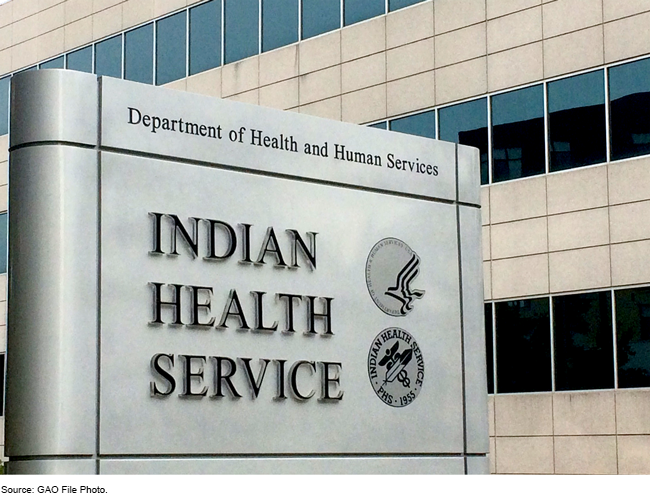Indian Health Service: Actions Needed to Improve Use of Data on Adverse Events
Fast Facts
The Indian Health Service provides care to 2.8 million American Indians and Alaska Natives.
Over a 2-year period, federal IHS facilities recorded more than 27,000 adverse events, including errors that:
could have or did cause harm to patients, like missed diagnoses
were prevented before they could cause harm, i.e., a "good catch"
IHS facility staff enter information on such events into a web-based system so IHS headquarters can oversee patient safety. But IHS headquarters doesn't use the data to track trends across regional areas.
We recommended it do so to better oversee potential safety issues.

Highlights
What GAO Found
The Indian Health Service (IHS) uses measures based on data from its electronic health record system to monitor health care quality. These measures cover areas of care such as diabetes management and access to dental services. IHS officials use these measures to identify areas for improvement and guide the development of initiatives to improve patient care. For example, officials from one IHS area office told GAO they implemented an initiative to increase alcohol screening rates after finding low screening rates at an area facility.
IHS uses a web-based incident reporting system, called the IHS Safety Tracking and Response system, to monitor adverse events—events that could have caused or did cause harm, damage, or loss to patients. IHS facility staff are responsible for entering information on adverse events from their facility into the system, and conducting an investigation and quality assurance review. Over a 2-year period, federally operated facilities recorded over 27,000 adverse events, including events that were prevented before reaching the patient. IHS area office officials may provide resources to help facilities complete investigations. IHS headquarters officials oversee specific high-risk adverse events.
IHS Safety Tracking and Response Adverse Event Process at Facilities

IHS recently developed standard reports for areas and facilities on trends in adverse events entered into its tracking system, but reports for headquarters do not include data on area- or facility-level trends needed to compare performance. Officials have not created such reports because they believe each area and facility should be assessed based on its distinct circumstances. However, comparing trends across areas and facilities does not preclude also looking at each location on its own. Without obtaining and regularly reviewing data on adverse event trends by location, IHS headquarters has limited information to provide management oversight on patient safety. Thus, it cannot effectively prioritize attention and resources or disseminate best practices, creating the potential for disparities in patient care based on location.
Why GAO Did This Study
American Indians and Alaska Natives are disproportionately affected by certain health conditions. This includes a higher mortality rate compared with the overall U.S. population. IHS provides care to about 2.8 million such individuals through a system of federally and tribally operated facilities. IHS's information technology systems contain information that can be used to monitor the quality of care provided to, and safety of, patients at federally operated facilities.
GAO was asked to review IHS's capacity for using its information technology systems to manage patient care and monitor adverse events. Among other objectives, this report examines how IHS (1) uses its electronic health record system to monitor health care quality at federally operated facilities and (2) monitors adverse events. GAO reviewed agency documents, including policies, meeting minutes and agendas. GAO also interviewed IHS officials from headquarters, four area offices, and four federally operated facilities.
Recommendations
GAO is making two recommendations to IHS. IHS headquarters should regularly review and compare data on adverse events trends for—at a minimum—each area and take steps, as appropriate, to make improvements and disseminate best practices in response to those trends. The Department of Health and Human Services concurred with these recommendations.
Recommendations for Executive Action
| Agency Affected | Recommendation | Status |
|---|---|---|
| Indian Health Service | The Director of IHS should ensure that the appropriate headquarters officials have access to, and regularly review and compare, data on trends in adverse events reported in its I-STAR system for—at a minimum—each area. Such data could include, for example, trends in the number of adverse events by category. (Recommendation 1) |
IHS concurred with this recommendation. In February 2024, IHS provided documentation that the agency had developed a quarterly report that included some area-level data on trends in adverse events. Specifically, the reports provide data over time, by area, on the number of patient safety events and good catches per quarter, as well as patient falls per month. In December 2024, IHS provided documentation that these reports were reviewed by headquarters officials including the Directors of the Office of Quality and the Division of Quality Assurance and Patient Safety.
|
| Indian Health Service | The Director of IHS should ensure that the appropriate headquarters officials take steps, as appropriate, to address any needed improvements or disseminate any best practices identified based on their review of data on trends in adverse events for—at a minimum—each area. (Recommendation 2) |
IHS concurred with this recommendation. In December 2024, IHS officials stated that a learning collaborative to identify and spread evidence-based practices and education to reduce inpatient falls and associated harm is a 2024 Total System Safety (TSS) implementation priority action. The workgroup is collecting baseline data to provide insight into what processes are currently in place at IHS hospitals to reduce inpatient falls. As IHS learns from this learning collaborative, GAO will review documentation of the results of the TSS efforts, including any steps taken to address any needed improvements or disseminate any best practices based on area trends related to falls. We will also continue to monitor whether IHS takes steps to address any needed improvements or disseminate any best practices related to other IHS area trends in adverse events.
|
